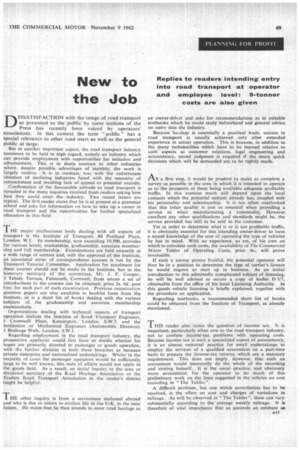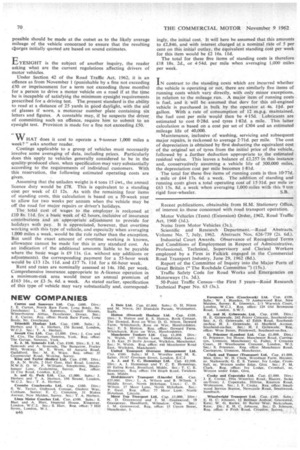• New to the Job
Page 71

Page 72

If you've noticed an error in this article please click here to report it so we can fix it.
DISSATISFACTION with the image of road transport as presented to the public by some sections of the Press has recently been voiced by operators' associations. In this context the term " public " has a special relevance to other road users as well as the general public at large.
But in another important aspect, the road transport industry continues to be held in high regard, namely an industry which can provide employment with opportunities for initiative and advancement. This is in sharp contrast to other industries where. despite possible advantages of stability, the work is largely routine. It is in contrast, too, with the unfortunate situation of declining industries faced with the necessity of retrenchment and resulting lack of appeal to potential recruits.
Confirmation of the favourable attitude to road transport is revealed in the many inquiries received from readers asking how best they could enter the industry. Two recent letters are typical. The first reader states that he is at present at a grammar school and asks for information on how to take up a career in road transport and the opportunities for further specialized education in this field
1' HE major professional body dealing with all aspects of transport is the Institute of Transport, 80 Portland Place, London. W.I. Its membership, now exceeding 10,500, provides for various levels; studentship, graduateship, associate membership and full membership. Examinations are held annually at a wide range of centres and, with the approval of the Institute, an associated series of correspondence courses is run by the Transport Tutorial Committee. Application for enrolment for these courses should not be made to the Institute, but to the honorary secretary of the committee, Mr. J. F. Cooper, 3 Tehidy Terrace, Falmouth, Cornwall, from whom a set of introductions to the courses can be obtained, price 2s. 6d. post free, for each part of each examination. Previous examination question papers are also available in booklet form from the Institute, as is a short list of books dealing with the various subjects of the graduateship and associate membership examinations.
Organizations dealing with technical aspects of transport operation include the Institute of Road Transport Engineers. I Cromwell Place, Kensington. London, S.W.7, and the Institution of Mechanical Engineers (Automobile Division), 1 Birdcage Walk, London, S.W.I.
Regarding employment in the road transport industry, the prospective applicant would first have to decide whether his hopes are primarily directed to passenger or goods operation, with the further division in both these branches as between private enterprise and nationalized undertakings. Whilst in the majority of cases the passenger operators would be sufficiently large to be well known, this state of affairs would not apply in the goods field. As a result, an initial inquiry to the area or divisional secretary of the Road Haulage Association or the Traders Road Transport Association in the reader's district might be helpful.
THE other inquiry is from a serviceman stationed abroad and who is due to return to civilian life in the U.K. in the near future. He states that he then intends to enter road haulage as an owner-dri‘er and asks for recommendations as to suitable textbooks which he could study beforehand and general advice on entry into the industry.
Because ha alage is essentially a practical trade, success in road transport is usually achieved only after extended experience in actual operation. This is because, in addition to the many technicalities which have to be learned relative to such aspects as customer relations, legal engineering and accountancy, sound judgment is required if the many quick decisions which will be demanded are to be rightly made.
AS a first step, it would be prudent to make as complete a survey as possible in the area in which it is intended to operate as to the prospects of there being available adequate profitable traffic. In this exercise much will depend upon the local contacts which the potential entrant already has, coupled with his personality and salesmanship. It is too often overlooked that this latter quality is just as essential when providing a service as when manufacturing a commodity. However excellent any other qualifications and standards might be, the service provided has still to be sold to the customer.
Yet in order to determine what is or is not profitable traffic, it is obviously essential for this intending owner-driver to have a sound knowledge of the cost of operating the type of vehicles he has in mind. With no experience, as yet, of his own on which to calculate such costs, the availability of The Commercial Motor Tables of Operating Costs, price 4s., will prove invaluable.
If such a survey proves fruitful, the potential operator will then be in a position to determine the type of carrier's licence he would require to start up in business. As an initial introduction to this admittedly complicated subject of licensing, he will be well advised to secure a copy of leaflet D 5/7, obtainable from the office of his local Licensing Authority. In this goods vehicle licensing is briefly explained, together with the procedure on application.
Regarding textbooks, a recommended short list of books could be obtained from the Institute of Transport, as already mentioned.
THIS reader also raises the question of income tax. It is important, particularly when new to the road transport industry, not to confuse income-tax problems with operating costs. Because income tax is such a specialized aspect of accountancy, it is an almost universal practice for small undertakings to employ the services of a qualified accountant on a part-time basis to prepare the income-tax returns, which are a statutory requirement. This does not imply, however, that such an accountant would necessarily do the whole of the recording and costing himself. It is the usual practice, and obviously more economical, for the operator to do much of this preliminary work on the lines suggested in the articles on cost recording in "The Tables ".
A difficult problem„ but one which nevertheless has to be resolved, is the effect on cost and charges of variations in mileage. As will be observed in "The Tables ", these can vary substantially according to the average weekly mileage. It is therefore of vital importance that as accurate an estimate as
possible should be made at the outset as to the likely average mileage of the vehicle concerned to ensure that the resulting cl,iarges initially quoted are based on sound estimates.
EYESIGHT is the subject of another inquiry, the reader asking what are the current regulations affecting drivers of motor vehicles.
Under Section 42 of the Road Traffic Act, 1962; it is an offence as from November 1 (punishable by a fine not exceeding £50 or imprisonment for a term not exceeding three months) for a person to drive a motor vehicle on a road if at the time he is incapable of satisfying the minimum eyesight requirements prescribed for a driving test. The present standard is the ability to read at a distance of 25 yards in good daylight, with the aid of glasses if worn, a motorcar number plate containing six letters and figures. A constable may, if he suspects the driver. of committing such an offence, require him to submit to an eyesight test. Provision is made for a fine not exceeding £50.
if T
W HAT does it cost to operate a 9-tonner 1,000 miles a week? " asks another reader.
.Costings applicable to a group of vehicles must necessarily involve some averaging of data, including prices. Particularly does this apply to vehicles generally considered to be in the quality-produced class, when specification may vary substantially according to the requirements of individual customers. With this reservation, the following estimated operating costs are given.
Assuming that the unladen weight is 4 tons 15 cwt., the annual licence duty would be £78. This is equivalent to a standing cost per week of £1 12s. As with the remaining four items of standing costs, this calculation is based on a 50-week year to allow for two weeks per annum when the vehicle may be off the road for major repairs or driver's holidays.
The total cost of wages to the employer is reckoned at £10 8s. 1.1d. for a basic week of 42 hours, inclusive of insurance contributions and ari appropriate adjustment to provide for holidays with pay. It is appreciated, however, that overtime working with this type of vehicle, and especially when averaging 1,000 miles a week, would be the rule rather than the exception. But until the exact amount of overtime working is known, allowance cannot be made for this in any standard cost. As an indication of the additional amounts liable to be payable where the basic wage is £9 I Is. (i.e. without any additions or adjustments). the corresponding payment for a 55-hour week would be £13 12s. I ld. and £17'7s. Ild, for a 66-hour week.
Rent and rates are nominally assessed at 14s. 10d. per week. Comprehensive insurance, appropriate to A-licence operation in a minimum-risk area would incur an annual premium of £163 16s., or £3. 5s. 6d. a week. As stated earlier, specification of this type of vehicle may vary substantially and, correspond
ingly, the initial cost. It will here be assumed that this amounts to £2,846, and with interest charged at a nominal rate of 5 per cent on this initial outlay, the equivalent standing eoit per week for this item would be £2 16s. Ild.
The total for these five items of standing costs is therefore £18 18s, 2d., or 4-54d. per mile when averaging 1,000 miles per week.
IN contrast to the standing costs which are incurred whether the vehicle is operating or not, there are similarly five items of running costs which vary directly, with only minor exceptions, in relation to the mileage run. A major item of running costs is fuel, and it will be assumed that dery for this oil-engined vehicle is purchased in bulk by the operator at 4s. lid. per gallon. With a rate of consumption of 12 m.p.g. maintained, the fuel cost per mile would then be 4-I5d. Lubricants are estimated to cost 0.28d. and tyres 1•82d. a mile. This latter calculation is based on a cost per set of £304 and an estimated mileage life of 40,000.
Maintenance, inclusive of washing, servicing and subsequent major repairs, is reckoned to average 2-71d. per mile. The cost of depreciation is obtained by first deducting the equivalent cost of the original set of tyres from the initial price of the vehicle, followed by a further deduction appropriate to., the estimated residual value. This leaves a balance of £2,257 in this instance and, conservatively assuming a vehicle life of 300,000 miles, the depreciation cost per mile becomes 1.81d.
The total for these five items of running costs is thus 10.774. a mile or £44 I7s. 6d, a week. The addition of standing and running costs gives a total operating cost of 15.31d. per mile M.. £63 15s. 8d. a week when averaging 1,000 miles with this 9 ton
rigid four-wheeler. S.B.












































































































